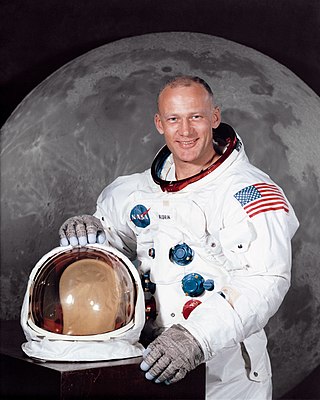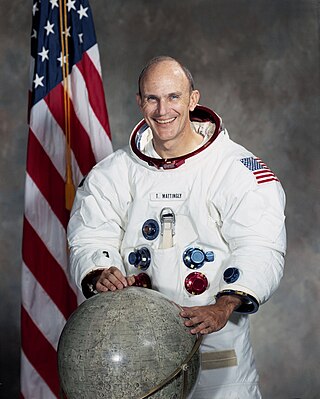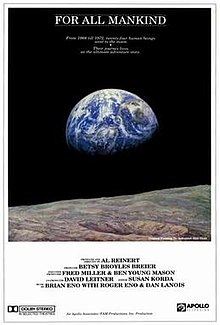
Apollo 11 was the American spaceflight that first landed humans on the Moon. Commander Neil Armstrong and Lunar Module Pilot Buzz Aldrin landed the Apollo Lunar Module Eagle on July 20, 1969, at 20:17 UTC, and Armstrong became the first person to step onto the Moon's surface six hours and 39 minutes later, on July 21 at 02:56 UTC. Aldrin joined him 19 minutes later, and they spent about two and a quarter hours together exploring the site they had named Tranquility Base upon landing. Armstrong and Aldrin collected 47.5 pounds (21.5 kg) of lunar material to bring back to Earth as pilot Michael Collins flew the Command Module Columbia in lunar orbit, and were on the Moon's surface for 21 hours, 36 minutes before lifting off to rejoin Columbia.

Apollo 8 was the first crewed spacecraft to leave low Earth orbit and the first human spaceflight to reach the Moon. The crew orbited the Moon ten times without landing, and then departed safely back to Earth. These three astronauts—Frank Borman, James Lovell, and William Anders—were the first humans to witness and photograph the far side of the Moon and an Earthrise.

The Apollo program, also known as Project Apollo, was the United States human spaceflight program carried out by the National Aeronautics and Space Administration (NASA), which succeeded in preparing and landing the first humans on the Moon from 1968 to 1972. It was first conceived in 1960 during President Dwight D. Eisenhower's administration as a three-person spacecraft to follow the one-person Project Mercury, which put the first Americans in space. Apollo was later dedicated to President John F. Kennedy's national goal for the 1960s of "landing a man on the Moon and returning him safely to the Earth" in an address to Congress on May 25, 1961. It was the third US human spaceflight program to fly, preceded by the two-person Project Gemini conceived in 1961 to extend spaceflight capability in support of Apollo.

Apollo 10 was the fourth human spaceflight in the United States' Apollo program and the second to orbit the Moon. NASA, the mission's operator, described it as a "dress rehearsal" for the first Moon landing. It was designated an "F" mission, intended to test all spacecraft components and procedures short of actual descent and landing.

Buzz Aldrin is an American former astronaut, engineer and fighter pilot. He made three spacewalks as pilot of the 1966 Gemini 12 mission. He was the Lunar Module Eagle pilot on the 1969 Apollo 11 mission and became the second person to walk on the Moon after mission commander Neil Armstrong.

Moon landing conspiracy theories claim that some or all elements of the Apollo program and the associated Moon landings were hoaxes staged by NASA, possibly with the aid of other organizations. The most notable claim of these conspiracy theories is that the six crewed landings (1969–1972) were faked and that twelve Apollo astronauts did not actually land on the Moon. Various groups and individuals have made claims since the mid-1970s that NASA and others knowingly misled the public into believing the landings happened, by manufacturing, tampering with, or destroying evidence including photos, telemetry tapes, radio and TV transmissions, and Moon rock samples.

Eugene Andrew Cernan was an American astronaut, naval aviator, electrical engineer, aeronautical engineer, and fighter pilot. During the Apollo 17 mission, Cernan became the eleventh human being to walk on the Moon. As he re-entered the Apollo Lunar Module after Harrison Schmitt on their third and final lunar excursion, he remains the most recent person to walk on the Moon.

John Watts Young was an American astronaut, naval officer and aviator, test pilot, and aeronautical engineer. He became the 9th person to walk on the Moon as commander of the Apollo 16 mission in 1972. He is the only astronaut to fly on four different classes of spacecraft: Gemini, the Apollo command and service module, the Apollo Lunar Module and the Space Shuttle.

Thomas Otten Paine was an American engineer, scientist and advocate of space exploration, and was the third Administrator of NASA, serving from March 21, 1969, to September 15, 1970.

Thomas Kenneth Mattingly II was an American aviator, aeronautical engineer, test pilot, rear admiral in the United States Navy, and astronaut who flew on Apollo 16 and Space Shuttle STS-4 and STS-51-C missions.

Project Gemini was the second United States human spaceflight program to fly. Conducted after the first, Project Mercury, and while the Apollo program was still in development, Gemini was conceived in 1961 and concluded in 1966. The Gemini spacecraft carried a two-astronaut crew. Ten Gemini crews and 16 individual astronauts flew low Earth orbit (LEO) missions during 1965 and 1966.

Lunar plaques are stainless steel commemorative plaques measuring 9 by 7+5⁄8 inches attached to the ladders on the descent stages of the United States Apollo Lunar Modules flown on lunar landing missions Apollo 11 through Apollo 17, to be left permanently on the lunar surface. The plaques were originally suggested and designed by NASA's head of technical services Jack Kinzler, who oversaw their production.

In the Shadow of the Moon is a 2007 British documentary film about the United States' crewed missions to the Moon. After premiering at the 2007 Sundance Film Festival, where it won the World Cinema Audience Award, it was given a limited release in the United States on 7 September 2007, and in Canada on 19 October.

When We Left Earth: The NASA Missions is a 2008 Discovery Channel HD documentary miniseries consisting of six episodes documenting American human spaceflight from the first Mercury flights and the Gemini program, to the Apollo program and its Moon missions and landings, to the Space Shuttle missions and the construction of the International Space Station.

Moonwalk One is a 1971 feature-length documentary film about the flight of Apollo 11, which landed the first humans on the Moon. Besides portraying the massive technological achievement of that event, the film places it in some historical context and tries to capture the mood and the feel of the people on Earth when man first walked on another world.
Al Reinert was an American journalist, film director, screenwriter and producer. He co-wrote the screenplays for the Ron Howard film Apollo 13 and Final Fantasy: The Spirits Within, but is best known for directing and producing For All Mankind, an award-winning 1989 documentary about NASA's Apollo program. He died of lung cancer at his home in Wimberley, Texas on December 31, 2018.

Apollo 11 was the first human spaceflight to land on the Moon. In the decades after its 1969 mission took place, widespread celebrations have been held to celebrate its anniversaries.

Apollo 11 is a 2019 American documentary film edited, produced and directed by Todd Douglas Miller. It focuses on the 1969 Apollo 11 mission, the first spaceflight from which men walked on the Moon. The film consists solely of archival footage, including 70 mm film previously unreleased to the public, and does not feature narration, interviews or modern recreations. The Saturn V rocket, Apollo crew consisting of Buzz Aldrin, Neil Armstrong, and Michael Collins, and Apollo program Earth-based mission operations engineers are prominently featured in the film.


















